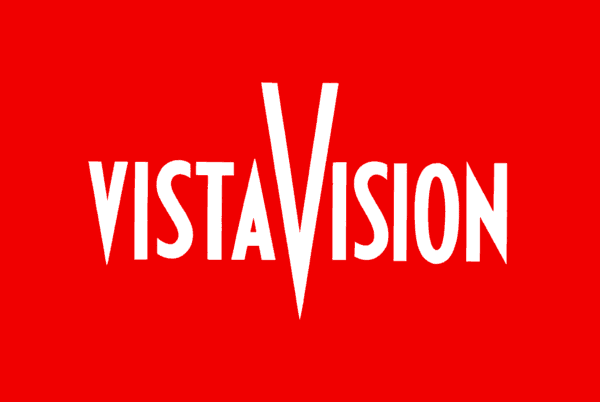
Gordon McLeod was kind enough to send us this entertaining, if not completely enlightening, large format book issued by Paramount to promote VistaVision over the competition's CinemaScope process. The VistaVision system was a very high quality photographic and printing process, but Paramount somehow felt it was necessary to play with the facts just a bit when they made comparisons with their system and CinemaScope. So take some of the contents of this booklet with a grain of salt.

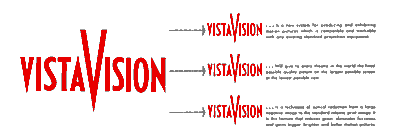

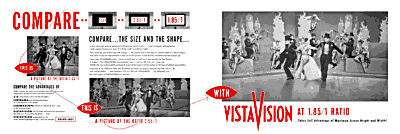
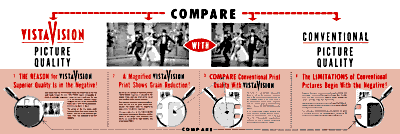
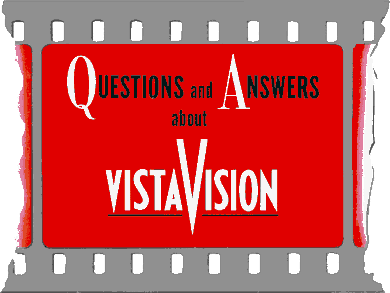
Briefly, what is VistaVision?VistaVision is a new production, release printing and theatre technique which will give theatres the finest possible quality on the largest possible screen at the lowest possible cost
Q What is VistaVision?
A VistaVision is a combined photographic and release printing process which brings to motion picture screens a picture quality and scope never before achieved. It is completely flexible and completely compatible with all standard existing equipment, and therefore requires no new equipment or special techniques in presentation. The improvement in picture image offered by VistaVision is achieved through the use of a new type of camera, which photographs the original negative on a double frame, through new wide-angle lenses. The VistaVision release prints are made by optical reduction and will play on any standard projection equipment in any aspect ratio from 1.33 1, the former standard, to an aspect ratio of 2 1. Since the best picture composition and the best theatre presentation will be obtained in the aspect ratio of 1.85/1, this ratio is recommended by the Paramount Studio technical staff.
A great deal of the present equipment in theatres, such as lamp houses, lenses and screens, is adequate for presentation of all the detail and beauty of the VistaVision print. In some cases, improved lamp houses, lenses and screens will be desirable to attain all the inherent beauty in VistaVision pictures.
Q What is the difference between the VistaVision camera and standard cameras?
A In the VistaVision camera, the film passes through the camera horizontally instead of vertically, as in standard cameras. Also, instead of exposing an area measured by 4 sprocket holes of negative, the VistaVision camera exposes an area measured by 8 sprocket holes for each frame of negative. The resultant negative area exposed for each frame is almost three times as large as the negative from any other motion picture camera. Everyone who has ever taken a photograph-even an inexpensive snapshot-will instantly realize that when a much larger negative is optically reduced-in the release print-to a standard size 35-millimeter print image, the resulting increase in clarity, sharpness and definition is amazing.
Q Is VistaVision exclusive with Paramount or is it available to all?
A Paramount has made VistaVision available to all producers and to all theatres without compensation, and in order to encourage the wider use of VistaVision for the advancement of motion pictures generally, has provided fully detailed data and specifications to all interested camera and equipment manufacturers. Paramount will not accept any royalties, payments or profits of any kind as a result of VistaVision. This policy-in keeping with Paramount's policy of many years' standing-has been officially enunciated by the top executives of the company and is made clearly and unequivocally, with no reservations of any kind. Anyone in the world who wishes to obtain VistaVision cameras or VistaVision equipment is completely free to do so without restriction of any kind, stated or implied. It is expected that all other processes will adopt the VistaVision large negative principle to improve their presentations.
Q Can any theatre play VistaVision pictures?
A YES. Because VistaVision prints are standard 35-millimeter in width and have standard optical sound tracks, VistaVision prints can play in any theatre in the world. Of course, those theatres which have high and wide screens will be able to get the greatest advantages from VistaVision. It will also be of interest to theatres that no extra training for their staffs is required for projecting VistaVision pictures.
Q Will it be necessary to remove seats in order to play VistaVision pictures?
A NO. The sharpness and clarity of VistaVision will make side and front seats more desirable than at any time in the past. Theatres that have removed seats for large screens can now re-install them.
Q How and why will VistaVision appeal to the public?
A A high quality of screen presentation, coupled with interesting and dramatic motion pictures, is the only combination which can be expected to retain public interest. Since VistaVision is the only process which offers the public the highest and widest pictures possible together with superlative screen quality in brilliance, gradation and sharpness, it is the only process which will guarantee greatest public acceptance and the greatest patronage. A fine motion picture, photographed in VistaVision, may be compared to a masterpiece of painting properly framed and properly displayed so that every value it possesses is enhanced and pointed up.
Q What are the advantages of the VistaVision picture?
A The quality improvement which VistaVision brings to the final picture image as projected onto the screen of the theatre is inherent in the print itself and has been put into the print during production, which means that the advantages of VistaVision remain an integral and permanent feature of every release print. Because of these improvements in clarity and sharpness, plus the elimination of all annoying grain, every VistaVision print may be projected at full height and full width to fill the screen of every theatre. The wider negative also makes possible a wider angle of view in the original photography, thus adding a new and thrilling greatness and spectacular realism to the release print when projected onto the screen.
Q Does an exhibitor have to buy anything in order to play VistaVision pictures?
A Nothing whatsoever. A tremendous improvement in the quality of his screen image will be found by every exhibitor through VistaVision without a single cent of investment. However, there are certain additional pieces of equipment which may be added to attain maximum results. Each of these will show a definite increase in the quality of the image on the screen. These added-and purely voluntary-units may include:
1. A large screen-preferably seamless-as high and wide as the theatre will permit.
2. Adequate projection lighting to illuminate the large screen properly.
3. Lenses of proper focal length to fill the screen completely.
4. Perspecta-Stereophonic Sound unit only if multiple horn system is desired.
Q What new lenses are needed and will they be immediately available?
A Standard lenses are used in the projection of VistaVision, and since these lenses are now available from theatre equipment supply houses, there is no time problem whatsoever. The only requirement is that the lenses used be of the proper focal length to fill the screen of the theatre.
Q Will Paramount supply squeezed prints for the prismatic expander (Tushinsky type) lenses?
A YES. In certain instances, under special circumstances (unusually large theatres and drive-ins requiring special screen consideration), where the exhibitor feels that an anamorphic or "squeezed" print will produce a better result on the screen, Paramount will supply a special squeezed print. Paramount does not insist on the use of the squeezed print in any situation, and will make such prints available as an extra service, upon the request of the exhibitor or his staff. This print, which will be squeezed in the ratio of 1 to 1.5, can be played with a variable anamorphic lens, such as the Tushinsky lens or any fixed lens which expand} in the 1 to 1.5 squeeze ratio.
Q What type of sound track is available with VistaVision?
A The sound track on VistaVision prints is simple and it is compatible. All VistaVision prints will carry a standard photographic single sound track that will play on any standard sound head in any theatre in the world. This same sound track has, in addition, the qualities which are necessary so that it can be reproduced in theatres equipped for Perspecta-Sound, thus giving the unusual stereophonic effectiveness available in that system.
Q Are any companies other than Paramount using Perspecta-Sound?
A YES. In addition to Paramount, it has been announced that Metro-Goldwyn-Mayer, Warner Bros. and others are adopting Perspecta-Sound.
Q Where can completely detailed technical information on VistaVision be obtained?
A Paramount Pictures has prepared a completely detailed technical description of all aspects of VistaVision, which is available at all Paramount exchanges as well as at the Home Office in New York and Paramount Studio in Hollywood.
Q What does Paramount gain from VistaVision?
A VistaVision is Paramount's contribution to the advancement of the motion picture art and wellbeing of the industry. Paramount and all other companies using VistaVision will benefit from a general increase in public interest in motion pictures which will result in greater theatre attendance, larger grosses and more revenue for both exhibitor and producer. Paramount will not receive a single cent in royalty or profit from the sale or use of VistaVision equipment.
Q Will there be a steady and continuing source of supply of VistaVision pictures?
A YES. Paramount Pictures has already announced ten major productions in VistaVision which are now either complete, currently shooting or soon to go before the cameras.
These are:
Irving Berlin's WHITE CHRISTMAS, starring Bing Crosby, Danny Kaye, Rosemary Clooney and Vera-Ellen. In Technicolor.
Hal Wallis' THREE RING CIRCUS, starring Dean Martin and Jerry Lewis with Zsa Zsa Gabor and Joanne Dru. In Technicolor.
STRATEGIC AIR COMMAND, starring James Stewart and June Allyson. In Technicolor.
THE COVERED WAGON, starring Alan Ladd and a big special cast. In Technicolor.
CATCH A THIEF, starring Cary Grant. Produced and directed by Alfred Hitchcock. In Technicolor.
THE ROSE TATTOO, Hal Wallis' production of Tennessee Williams' Broadway stage success, starring Burt Lancaster.
ANGELS' COOKING, starring Humphrey Bogart in an adaptation of the international stage success .
RUN FOR COVER, starring James Cagney. In Technicolor.
THE LOVES OF OMAR KHAYYAM, an exotic, romantic musical based on the life of the poet who wrote "The Rubaiyat." In Technicolor.
THE COURT JESTER, starring Danny Kaye. Produced by Norman Panama and Melvin Frank. In Technicolor.
In addition, other producers have already announced that they will film pictures in VistaVision, and still other producers will shortly make similar announcements. All this means that VistaVision pictures of major importance to the industry will be available in ever-increasing supply.
Another Way To Look At Projected Image Sizes
In total contradiction of Paramount's methods©1954 Paramount Pictures Corp. / HTML Transcription ©1998 The American WideScreen Museum
Thanks, Gord!
Return To The Library Index